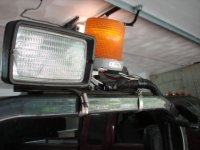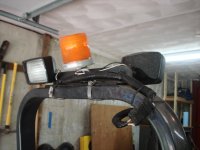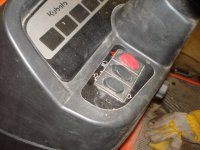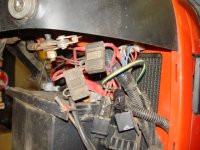BXRICK
Silver Member
Since everyone else has, I thought I'd describe and show
my work-light installation. I did this four years ago,
but the question gets asked often enough, I thought I'd show
yet one more variation on installing work lights.
First, I figured out how much light I could install on my BX1500.
I wanted front and rear lights, on at the same time, and a strobe
light for when I'm clearing snow and have to go in or near the road.
As I've stated elsewhere, criteria for work lights is:
- You don't need 1-mile driving lights. You're never going fast enough to
need them.
- Wide-angle floods are what you want.
- I don't see a reason to switch front and rear separately (though some may).
In my (limited) experience, I switch direction often enough that having both
on at the same time is useful.
My BX1500 has somewhere around a 14amp alternator (generator, whatever).
I want a few amps left over for battery charging.
If I use two 55-watt lights that works out to 55/12 = ~4.5 amps per light,
or about 9 amps. A strobe light uses less than 1 amp.
So, we're at about 10 amps, maybe 11 at the outside or so, which is
about right.
I purchased two 55-watt work lights, and a strobe light from AWDirect.
Not the cheapest, but in my experience always good, quick service.
I decided that the top of the ROPS was the way to go. I don't hit many trees.
It still allows the tractor to fit in the shed and garage.
I cut a piece of angle iron about a foot long. At the time, I had no welder.
I drilled/cut two slots where the two sides of the angle come together.
This allowed me to use hose clamps to clamp the angle to the top of
the ROPS. I cut a piece of heavy (1/4") rubber to go between the angle and
the ROPS. This prevents rattling.
On to the wiring.
I wanted to be able to remove the angle and lights for maintenance, or
low clearance, or some other odd situation. Which meant the wiring should
have a plug in it.
I bought a 4-prong trailer wiring harness. I wired the lights to one side
and the tractor to the other side, with the plug up on top of the ROPS.
I used tie wraps to hold the wiring to the ROPS.
I used one wire for the strobe, and one wire for each of the lights.
The ground is connected to the seatbelt bolt at the bottom of the ROPS.
The rest of the wiring goes down under the tractor, and along the frame.
It then comes back up near the alternator, and into the "under-dash" area
on the BX. The wiring under the tractor and up the ROPS is inside plastic
split loom.
After some thought, I realized that I couldn't come up with a reason to
switch the work lights separately from the factory headlights.
Same goes for the strobe - I couldn't find a reason to turn on the hazard blinkers
that I woudn't also want the strobe, or vice-versa.
So, I decided to use the factory switches to turn on my add-on lights.
This also avoided drilling holes and mounting extra switches - call me lazy and cheap.
I tapped into the headlight and blinker switched wires under the dash. Each tapped
wire then triggers a relay. The relays' switched power comes from a wire directly on
the battery, first going through a fuse.
The attached pictures show front and rear views of the lights. Also attached are a
picture of the completly stock looking switch area, and a shot of the added rats nest
of wiring under the switches - visible are two relays and two fuses.
This setup has worked flawlessly for four years now. And, despite the fact I easily
could, I have yet to remove the lights from the ROPS for any reason.
my work-light installation. I did this four years ago,
but the question gets asked often enough, I thought I'd show
yet one more variation on installing work lights.
First, I figured out how much light I could install on my BX1500.
I wanted front and rear lights, on at the same time, and a strobe
light for when I'm clearing snow and have to go in or near the road.
As I've stated elsewhere, criteria for work lights is:
- You don't need 1-mile driving lights. You're never going fast enough to
need them.
- Wide-angle floods are what you want.
- I don't see a reason to switch front and rear separately (though some may).
In my (limited) experience, I switch direction often enough that having both
on at the same time is useful.
My BX1500 has somewhere around a 14amp alternator (generator, whatever).
I want a few amps left over for battery charging.
If I use two 55-watt lights that works out to 55/12 = ~4.5 amps per light,
or about 9 amps. A strobe light uses less than 1 amp.
So, we're at about 10 amps, maybe 11 at the outside or so, which is
about right.
I purchased two 55-watt work lights, and a strobe light from AWDirect.
Not the cheapest, but in my experience always good, quick service.
I decided that the top of the ROPS was the way to go. I don't hit many trees.
It still allows the tractor to fit in the shed and garage.
I cut a piece of angle iron about a foot long. At the time, I had no welder.
I drilled/cut two slots where the two sides of the angle come together.
This allowed me to use hose clamps to clamp the angle to the top of
the ROPS. I cut a piece of heavy (1/4") rubber to go between the angle and
the ROPS. This prevents rattling.
On to the wiring.
I wanted to be able to remove the angle and lights for maintenance, or
low clearance, or some other odd situation. Which meant the wiring should
have a plug in it.
I bought a 4-prong trailer wiring harness. I wired the lights to one side
and the tractor to the other side, with the plug up on top of the ROPS.
I used tie wraps to hold the wiring to the ROPS.
I used one wire for the strobe, and one wire for each of the lights.
The ground is connected to the seatbelt bolt at the bottom of the ROPS.
The rest of the wiring goes down under the tractor, and along the frame.
It then comes back up near the alternator, and into the "under-dash" area
on the BX. The wiring under the tractor and up the ROPS is inside plastic
split loom.
After some thought, I realized that I couldn't come up with a reason to
switch the work lights separately from the factory headlights.
Same goes for the strobe - I couldn't find a reason to turn on the hazard blinkers
that I woudn't also want the strobe, or vice-versa.
So, I decided to use the factory switches to turn on my add-on lights.
This also avoided drilling holes and mounting extra switches - call me lazy and cheap.
I tapped into the headlight and blinker switched wires under the dash. Each tapped
wire then triggers a relay. The relays' switched power comes from a wire directly on
the battery, first going through a fuse.
The attached pictures show front and rear views of the lights. Also attached are a
picture of the completly stock looking switch area, and a shot of the added rats nest
of wiring under the switches - visible are two relays and two fuses.
This setup has worked flawlessly for four years now. And, despite the fact I easily
could, I have yet to remove the lights from the ROPS for any reason.



